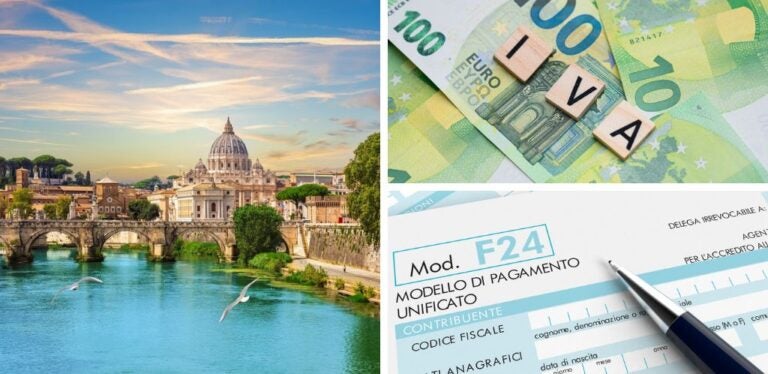Learn all about taxes in Italy: What should you pay?
Are you planning to move to Rome or any other Italian city? Find out here about taxes in Italy for individuals and companies.
Who wouldn’t want to move to Italy? With its cities rich in history, incredible food, and the stunning landscapes of Tuscany, it offers so much. But before you pack your bags and dive into the dolce vita, there are a few things you should consider to ensure a stable new life. Today, we’ll focus on taxes in Italy. The tax system in your country can have a big impact on your finances and overall quality of life. In Italy, the tax situation is quite varied and can be a little complex. In fact, in many cases, the tax rates are higher than the European average.
Italy has a tax system in place to fund its extensive public services. On top of national taxes, you’ll also need to account for local and regional taxes, which vary depending on the city or area where you choose to live. To help you get a clearer picture and decide if moving to Italy or investing there makes sense financially, let’s break down all the taxes you’ll face if you decide to settle in places like Rome, Florence, Capri, or any other part of the country. Let’s dive in!
Taxes for individuals in Italy
Before we get into the specifics of taxes in Italy, it’s important to understand how the system works. Italy’s tax structure blends direct and indirect taxes to fund a strong welfare system, ensuring access to quality services like healthcare and education. While it may seem complicated at first, it’s actually easier to navigate than it looks.
In Italy, your tax obligations depend largely on your residency status. If you live in the country for more than 183 days a year or have your primary economic interests there, the authorities will consider you a tax resident. This means you’ll have to report all your income, not just what you earn within Italy. Non-residents, however, are only taxed on income earned in Italy. Let’s take a look at the key taxes that apply to individuals in Italy.

1. Personal Income Tax (IRPEF)
If you move to Italy, the Personal Income Tax (IRPEF) will be the main tax affecting your tax return. It’s a key component of the Italian tax system and significantly impacts personal finances. The tax is progressive, meaning that the more you earn, the higher the rate you’ll pay. It works with different income brackets, ensuring that those with higher earnings contribute more. For 2025, here are the rates you’ll encounter:
- Up to 15,000 euros ($16,365): 23%.
- From 15,001 to 28,000 euros ($16,366 to $30,550): 25%.
- From 28,001 to 50,000 euros ($30,551 to $54,552): 35%.
- More than 50,000 euros: 43%.
If this seems confusing, let me break it down with an example. Let’s suppose you have an annual income of 40,000 euros ($43,641). This is how IRPEF is calculated:
- First bracket: 23 % on the first 15,000 euros ($16,365) = 3,450 euros ($3,770).
- Second bracket: 25% on the next 13,000 euros (28,000 – 15,000) = 3,250 euros ($3,765).
- Third bracket: 35% on the remaining 12,000 euros ($14,1835) (40,000 – 28,000) = 4,200 euros ($4,285).
Total to be paid: 10,900 euros ($11,895).
Italy offers tax deductions for large families, education expenses, and housing rentals, which can significantly reduce the final amount you owe. This makes the IRPEF system more flexible for those with family responsibilities or those investing in the country. We’ll go into more detail about these tax benefits later on.
2. Regional income tax (Addizionale Regionale IRPEF)
When you move to Italy, you’ll also have to pay the Regional Income Tax, in addition to the national IRPEF. This tax is used by the different regions to fund services like healthcare and education. Each region sets its own rate, which can vary between 1% and 3.3% of your taxable income.
Unlike the IRPEF, which is the same across the entire country, this tax can vary significantly depending on where you choose to live. For instance, regions like Lombardy generally have lower rates, while others, like Lazio or Sicily, tend to apply rates closer to the upper limit.
Italy isn’t alone in having regional income taxes. For example, Germany imposes a “Kirchensteuer” or church tax, which can be as high as 9% in certain states, though it goes toward a different cause. In Spain, some regions have the power to adjust income tax rates, but these changes are usually less significant compared to Italy.
3. Municipal Income Tax (Addizionale Comunale IRPEF)
In Italy, there’s one more income tax to pay as an individual – the municipal tax. Known as the Addizionale Comunale IRPEF, it’s set by local councils and varies depending on the municipality where you live. The rates range from 0.1% to 0.9% of your taxable income. The tax is used to fund municipal services like street lighting, public transport, and waste management.
4. Value Added Tax (VAT)
Another tax you’ll notice in Italy is the Value Added Tax (VAT), or Imposta sul Valore Aggiunto. They apply this indirect tax to the consumption of goods and services. Most things you buy already include it in the price, from food and clothing to electronics or even a simple meal at a restaurant.
VAT is a key source of income for the Italian government, and the rate can differ depending on the product or service. While 22% might seem a bit high compared to other European countries, it’s still lower than in places like Hungary (27%) or Denmark and Sweden (25%). Here’s a breakdown of the VAT rates in Italy:
- 22%: Standard rate for general products and services (clothing, technology, transport etc.).
- 10%: Reduced rate, applied to hospitality, public transport and some cultural services.
- 5%: Super-reduced rate for basic foods and social services.
- 4%: Specific rate for basic foods, books and other products considered essential.
Suppose you buy a laptop in Italy with a base price of 1,000 euros ($1,091). With VAT at 22%, the final cost will be 1,220 euros ($1,331). On the other hand, if you buy a book for 20 euros ($21.82), the reduced VAT of 4% will make you pay only 20.80 euros ($22.69) in total.
Important: If you are a frequent traveler and want to stay connected without worrying about expensive roaming or looking for a new SIM at every destination, Holafly’s subscription plans are for you. With a single eSIM, enjoy internet in more than 170 countries for a fixed price and no surprises on your bill. travel without limits and connect easily and securely! 🚀🌍

5. Property Tax (Imposta Municipale Unica – IMU)
Planning to stay for a while and buy a home? If so, you’ll need to consider the Property Tax. Known as IMU (Imposta Municipale Unica), it applies to real estate and is managed locally. While primary residences are usually exempt, there are exceptions, such as luxury properties.
The IMU is based on the property’s cadastral value, which is typically lower than its market value. As a result, while it’s an ongoing cost, it’s generally more affordable compared to similar taxes in other European countries. For example, in Spain, the tax is also calculated using the cadastral value, but the rates tend to be higher, ranging from 0.4% to 1.1%.
How much IMU is paid in Italy?
The IMU rate ranges from 0.4% to 0.76% of the cadastral value, depending on the region or municipality. Since each local area has the authority to set its own rate within these limits, the cost can vary considerably depending on the property’s location.
Let’s say you buy a second home in Rome with a cadastral value of 300,000 euros ($327,315). If the local rate is set at 0.6%, your annual tax would be 1,800 euros ($1,900). However, if you buy a similar property in a small town in Tuscany, where the rate is 0.4%, your tax would be 1,200 euros ($1,270).
6. Other important taxes for individuals in Italy
In addition to the above, there are other taxes that may affect your finances if you decide to move to Italy:
- Inheritance and gift tax: Applied to inheritances and transfers of property, with rates ranging from 4% to 8% (depending on the degree of kinship).
- Local and regional taxes: Municipalities may levy additional taxes to finance local services, such as garbage collection or public transportation.
- Tax on financial income: Interest, dividends and capital gains are taxed at a flat rate of 26%.
- Television license fee (Canone RAI): While it’s not a traditional tax, it’s mandatory for anyone who owns a TV. The annual fee is fixed at 90 euros (about $95), and it’s used to fund Italy’s public television service (RAI). It’s usually included in your electricity bill.
Taxes for legal entities or companies in Italy
Are you considering Italy’s tax system for starting a business? While Italy doesn’t have a reputation for being the most business-friendly country, it maintains tax rates for companies that align with global averages. Plus, running a business there comes with great perks: access to a market of over 60 million consumers, top-notch infrastructure, and a thriving business environment. Understanding the taxes you’ll need to pay is key to taking full advantage of these opportunities and making smart choices for your business. Let’s explore the main ones.

1. Corporate income tax (IRES)
The corporate tax, known as IRES, is the most important tax for businesses in Italy. It applies to net profits, meaning the amount remaining after deducting all operational expenses, salaries, and other business-related costs.
The standard IRES rate is 24%, which is slightly lower than countries like Germany, where it can exceed 30%. However, it’s higher than more tax-friendly destinations like Ireland, which offers a competitive rate of 12.5%.
How do you calculate it?
Let’s imagine that your company has an annual net profit of 500,000 euros ($545,523). The IRES calculation would be:
- 24% on 500,000 euros : 120,000 euros ($130,925).
2. Regional tax on productive activities (IRAP)
IRAP (Imposta Regionale sulle Attività Produttive) is a tax unique to Italy, applied to businesses’ economic activities. It helps fund healthcare services in the regions.
IRAP rates:
- Baseline rate of 3.9% on net value added (not on profits).
- Regions are free to adjust the rate by up to an additional 1% or apply specific exemptions.
IRAP is not applied to profits; instead, it’s based on the added value a business generates. This includes revenue minus the cost of goods and services purchased. However, it excludes expenses related to employees and financing.
Practical example:
A company generating an aggregate value of 500,000 euros ($545,523) in a region with a rate of 4 %:
- 4 % of 500,000 euros = 20,000 euros ($21,820) IRAP.
3. Value Added Tax (VAT)
In Italy, businesses must manage the Value Added Tax (VAT) on goods and services sold. Even though the consumer ultimately pays the tax, companies are responsible for collecting it. The rates vary depending on the type of product or service.
- 22%: Standard rate (technological products, clothing, general services).
- 10%: Reduced rate (hotels and restaurants, passenger transportation).
- 5% and 4%: Applied to basic products such as food, books and essential medicines.
Businesses can deduct input VAT on the purchase of goods or services related to their activity. Reducing the amount that they must transfer to the State.
Suppose you have a company and you sell a product for 10,000 euros ($10,900) with VAT at 22%. The customer pays 12,200 euros ($13,300). If the company purchased that product for 6,000 euros ($7,200) plus VAT (7,320 euros) ($7,990):
- VAT collected from the customer: 2,200 euros ($2,400).
- VAT incurred by the company: 1,320 euros ($1,440).
- VAT to be transferred to the State: 880 euros ($960).
4. Corporate social contributions
If you have employees, you’ll need to account for social security contributions in addition to their salaries. These contributions go beyond just being a tax obligation—they help fund important services like pensions, public healthcare, and unemployment or workers’ compensation. Essentially, they’re an investment in both the workforce’s well-being and the overall social stability of the country.
The contribution rates range from 30% to 35% of an employee’s gross salary. These rates can differ depending on the industry and where the company is located. In certain regions, there are incentives to reduce these costs, particularly for strategic sectors or areas that are less developed.
For example, if you hire an employee with a gross salary of 2,000 euros ($2,180) per month, the corporate social contributions could be between 600 and 700 euros ($655-760) per month. This would cover aspects such as:
- Pensions: Funding of the public retirement system.
- Health care: Access to Italian public health care, considered one of the best in Europe.
- Unemployment and occupational risk insurance: Protection for workers in the event of dismissal or occupational accidents.
Italy isn’t the only country with such high rates. In France, this tax can exceed 45% of the gross salary.
Tax benefits in Italy
Despite its reputation for high taxes, Italy offers a range of tax incentives aimed at attracting both new residents and foreign businesses. These benefits are designed to boost investment, encourage job creation, and revitalize key sectors. If you’re considering relocating or starting a business in Italy, understanding these perks can help you reduce your tax burden and make the most of the opportunities the country has to offer.

Main tax benefits in Italy:
- Tax regime for expats: Foreign workers who move to Italy can benefit from an exemption of up to 70% of their income during the first five years of residence. This percentage can rise to 90% if you move to a southern region of Italy, such as Sicily or Calabria.
- Incentives for entrepreneurs: Startups and innovative companies can take advantage of partial exemptions from the Regional Tax on Productive Activities (IRAP) and social contributions during their first few years of operation.
- Deductions for real estate investment: If you invest in residential rental properties through programs like the “Italian Pinel Plan,” you can benefit from significant tax deductions on your income tax return.
- Special Economic Zones (ZES): Companies operating in less developed regions, such as southern Italy, can benefit from a reduction in the Corporate Tax (IRES) and exemptions from certain local taxes.
- R&D tax credits: Companies that invest in research and development can take advantage of tax credits that cover up to 50% of the costs associated with these activities.
- Benefits for foreign retirees: If you retire in Italy and choose to live in smaller towns in the south, you can benefit from a reduced tax rate of 7% on your income for the first ten years.
Although taxes in Italy might seem a bit high, the country also offers tax incentives that can significantly reduce the burden for expats and businesses. If you’re planning to move or invest in Italy, it’s essential to take a deep dive into its tax benefits and obligations before making any decisions. Consulting with a professional who understands your situation can help you develop a tax strategy that suits your needs and optimizes your finances. And don’t forget to grab your Holafly eSIM to reach out with any questions when you arrive!
Frequently asked questions about taxes in Italy
Individuals file tax returns annually. Generally, they must submit them between May and June, depending on whether they file in person or online. The Agenzia delle Entrate, Italy’s tax agency, usually announces the exact dates each year. It’s important to file on time to avoid any penalties.
If you’re behind on your taxes in Italy, you could face fines that depend on the severity of the delay. Late fees typically amount to 30% of the owed amount, plus daily interest. In more serious cases, authorities could take legal action, potentially imposing garnishments or restrictions. Staying up to date with your taxes is crucial to avoid financial issues.
Your tax residency status determines how to file taxes in Italy. Fiscal residents, those who spend more than 183 days a year in the country or have their main economic interests there, must report their worldwide income. On the other hand, Italy taxes non-residents only on income they earn within the country, though they may face higher rates.
If you work remotely for a foreign company and don’t earn income in Italy, you might not have to pay local taxes. However, if you become a tax resident or engage in business activities in the country, you’ll need to fulfill Italy’s tax obligations. Consider looking into options like the digital nomad visa in Italy, which could simplify your legal and tax situation.
Italy offers an appealing program called the “Expatriate Regime” (Regime Impatriati), which allows new tax residents to be taxed on just 30% of their income for the first five years. In some regions of southern Italy, local authorities can further reduce this tax rate to as low as 10%.
When buying property in Italy, you’ll be subject to taxes like the Registration Tax (2% for a first home or 9% for second properties) and VAT if purchasing from a developer (4%, 10%, or 22%, depending on the type of property). Additionally, you’ll need to pay the IMU (Imposta Municipale Unica) if the property isn’t your primary residence.
In Italy, there are several banks that cater to both locals and expats, such as UniCredit, Intesa Sanpaolo, and BNL. These banks offer accounts tailored for freelancers and expats, providing features like electronic invoicing and automatic tax payments. Additionally, many of them offer services for managing international transfers, which is especially beneficial for people dealing with multiple currencies.
Italy does provide tax breaks for things like family expenses, housing rentals, and education. You can also benefit from deductions for investments in renewable energy or for restoring historic properties. Using these incentives can help lower your overall tax liability.





 Language
Language 


















 No results found
No results found







